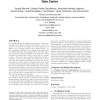Free Online Productivity Tools
i2Speak
i2Symbol
i2OCR
iTex2Img
iWeb2Print
iWeb2Shot
i2Type
iPdf2Split
iPdf2Merge
i2Bopomofo
i2Arabic
i2Style
i2Image
i2PDF
iLatex2Rtf
Sci2ools
MOBICOM
2012
ACM
2012
ACM
CloudIQ: a framework for processing base stations in a data center
The cellular industry is evaluating architectures to distribute the signal processing in radio access networks. One of the options is to process the signals of all base stations on a shared pool of compute resources in a central location. In this centralized architecture, the existing base stations will be replaced with just the antennas and a few other active RF components, and the remainder of the digital processing including the physical layer will be carried out in a central location. This model has potential benefits that include a reduction in the cost of operating the network due to fewer site visits, easy upgrades, and lower site lease costs, and an improvement in the network performance with joint signal processing techniques that span multiple base stations. Further there is a potential to exploit variations in the processing load across base stations, to pool the base stations into fewer compute resources, thereby allowing the operator to either reduce energy consumption b...
| Added | 27 Sep 2012 |
| Updated | 27 Sep 2012 |
| Type | Journal |
| Year | 2012 |
| Where | MOBICOM |
| Authors | Sourjya Bhaumik, Shoban Preeth Chandrabose, Manjunath Kashyap Jataprolu, Gautam Kumar, Anand Muralidhar, Paul A. Polakos, Vikram Srinivasan, Thomas Woo |
Comments (0)

